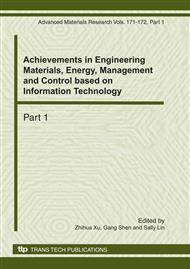[1]
Pew-Thian Yap, Raveendran Paramesran, Seng-Huat Ong. Image Analysis by Krawtchouk Moments [J]. IEEE Trans On Image Processing, 2003, 12(11): 1367-1377.
DOI: 10.1109/tip.2003.818019
Google Scholar
[2]
Ng, B, Abugharbieh, R, Xuemei Huang. Spatial Characterization of fMRI Activation Maps Using Invariant 3-D Moment Descriptors [J]. IEEE Transactions on Medical Imaging, 2009, 28(2): 261-268.
DOI: 10.1109/tmi.2008.929097
Google Scholar
[3]
Hu M K. Visual pattern recognition by moment invariants [J]. IRE Trans on Information Theory, 1962, 8(2): 179-187.
DOI: 10.1109/tit.1962.1057692
Google Scholar
[4]
Wong Y R. Scene matching with invariant moments [J]. Computer Graphics and Image Processing, 1978, 8(1): 16-24.
DOI: 10.1016/s0146-664x(78)80028-8
Google Scholar
[5]
Chen Chaur-Chin. Improved moment invariants for shape discrimination [J]. Pattern Recognition, 1993, 26(5): 683-686.
DOI: 10.1016/0031-3203(93)90121-c
Google Scholar
[6]
WANG Shi-long, WAN Lei, TANG Xu-dong. A modified fast fuzzy C-means algorithm based on the spatial information for underwater image segmentation. International Conference on Computer Design and Applications [C], 2010, Vol1: 1524-1528.
DOI: 10.1109/iccda.2010.5540706
Google Scholar
[7]
Yuan X H, Qiu C C, et al. Vision System Research for Autonomous Underwater Vehicle [C]. Proceedings of the IEEE International Conference on Intelligent Processing System, 1997: 1465-1469.
DOI: 10.1109/icips.1997.669263
Google Scholar
[8]
ZHANG Yu-jin. Image Segmentation[M]. Beijing: Science Press, (2001).
Google Scholar
[9]
CHEN Liang. A research in Pattern Recognition of Underwater Object based on Image Proeessing [D]. Haerbin: Harbin Engineering Uiversity, 2006: 31-40.
Google Scholar
[10]
ZHU Wei. Research on Underwater Image Segmentation and Pattern Recognition Based on Particle Swarm Optimization [D]. Haerbin: Harbin Engineering Uiversity, 2008: 95-99.
Google Scholar
[11]
TANG Xu-dong, ZHU Wei, PANG Yong-jie. Target Recognition System Based on Optical Vision for AUV [J]. ROBOT. 2009, 31(2): 171-178.
Google Scholar
[12]
ZHANG Zhong-hua, YANG Shu-ying. Image Clustering Design Based on Genetic Algorithm[J]. Measurement & Control Technology, 2010, 29(2): 44-47.
Google Scholar


